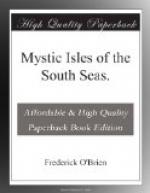A chorus of wives and widows—there were no old maids in Tahiti—condemned scathingly the conduct of the voluptuaries, and the preachers of the gospel lashed them in conversation or sermon now and then. But on the whole there was not in Tahiti any of the spirit of American towns and villages, which wrote scarlet letters, ostracized offenders against moral codes, and made Philistinism a creed. Gossip was constant, and while sometimes caustic, more often it partook of curiosity and mere trading of information or salacious prattle.
Tahitian women concealed nothing. If they won the favors of a white man, they announced it proudly, and held nothing sacred of the details. One’s peculiarities, weaknesses, idiosyncrasies, physical or spiritual blemishes, all became delectable morsels in the mouths of one’s intimates and their acquaintances. One’s passions, actions, and whisperings were as naked to the world as the horns on a cow. Every one knew the import of Polonsky’s dorsal tattooings, that Pastor —— had a case of gin in his house, and that the governor, after a bottle or two of champagne, had squeezed so tightly the waist of an English lady with whom he waltzed that she had cried out in pain. Though bavardage accounted for much of the general knowledge of every one’s affairs, there was an uncanny mystery in the speed at which a particular secret spread. One spoke of the bamboo telegraph.
It was proposed at the Cercle Bougainville that we have a series of jaunts to points some distance away. I was promised that I would see fully the way my acquaintances enjoyed themselves in the open. Llewellyn was given charge of the first excursion. It was to Moorea, an island a dozen miles or so to the northwest from Papeete, and which, with Tetiaria and Mehetia and Tahiti, constitute les iles de Vent, or Windward Islands of the Society archipelago.
In clear weather one cannot look out to sea from Papeete, to the north or west, without Moorea’s weird grandeur confronting one. The island of fairy-folk with golden hair, it was called in ancient days by the people of other islands. A third of the size of Tahiti, it was, until the white man came, the abode of a romantic and gallant clan. Eimeo, it was called by the first whites, but the name of Moorea clings to it now. Over it and behind it sets the sun of Papeete, and it is associated with the tribal conflicts, the religion, and the journeys of the Tahitians. Now it is tributary to this island in every way, and small boats run to and from with passengers and freight almost daily.
We met at seven o’clock of a Saturday morning at the point on the coral embankment where the Potii Moorea was made fast, the gasolene-propelled cargo-boat which we had rented for the voyage. A hundred were gathered about a band of musicians in full swing when I appeared at the rendezvous on the prick of the hour. The bandsmen, all natives but one, wore garlands of purau, the scarlet hibiscus, and there was an atmosphere of abandonment to pleasure about them and the party.




